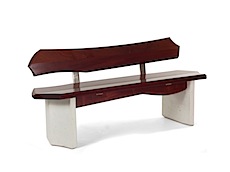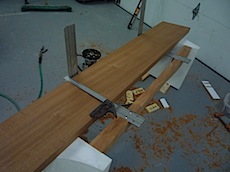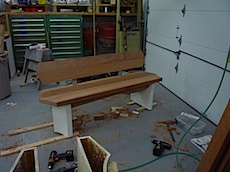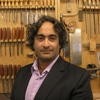Bench #5 from Bench Series #2
The distinguishing features of the benches in this series is that they can be made to go indoors or out. The first version of this bench went outdoors. This one is designed to go indoors. Here they are side by side. You can see that they are very different and I am not just talking about the materials. My style allows for variation and these two benches illustrate that point. They are far from duplicates, far from being part of an edition. They are each a unique composition.


Sapele is a cousin of the Mahogany tree that is native to Affrica. I have been enjoying working with it as of late. The grain and the potential to be chemically aged, like this piece is very attractive to me. The chemical that i use fully reacts with tannins in Sapele and ages it to its maximum patina. Just like pressing fast forward! The natural depth that the grain has is maintained because the color comes from within the wood. A traditional stain or dye add pigment to achieve color resulting in muted depth to the grain.
The following series of pictures will illustrate how I approach both construction and composition. The cast concrete is poured into a pair of forms just visible in the second photo below (lower left). The first picture shows how the sapele stretchers butt up against the concert legs. I designed the joint to be very strong and to relate to traditional construction techniques. The seat and the back in the second photo are about to get cut, shaped and faceted into their final form. At this point the piece could go in an unlimited number of directions. This is the flexibility of the way I approach my material.


The first movement often sets the process in motion. In this case the first move was shaping the stretcher below the seat. This threw the composition out of balance and I reacted to it with a movement under the left side of the seat back.

This process continues as I move around the piece. There are moments where I do not want a big bold cut. In those situations I can use the facet. Light reflects differently and i can use them to balance the composition.

I should mention something about the seat back. The bench has evolved with comfort in mind. The back now has a positive curve for lumbar support. Combine this with the curved seat pan and this is an amazing comfortable bench.


I always sign and date my work.

Bench #5 from Bench Series #2
Sapele, White Cast Concrete and Stainless Steel, 29H x 67W x 18D
I picture this bench finding a home in need of a piece of furniture to anchor a wall. An entrance way would be perfect. The bench could also hold its own in the center of a room due to the sculptural view from the back.
Bench #5 can also be viewed on this page with the added feature of a 360° View
 By Nico Yektai -
By Nico Yektai -New York based designer/maker Nico Yektai opened the doors to his Hamptons studio in 1995 after completing the MFA program at the School For American Craft at the Rochester Institute of Technology. The rigorous technical training complimented his background in Art History, which he studied, at Hobart College in Geneva NY. Yektai has synthesized this background into a singular style that has gained him national attention. Visit nicoyektai.com for more information